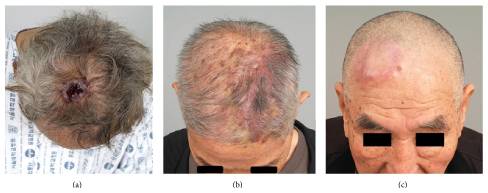|
Angiosarcoma
Angiosarcoma is a rare and aggressive cancer that starts in the endothelial cells that line the walls of blood vessels or lymphatic vessels. Since they are made from Endothelium, vascular lining, they can appear anywhere and at any age, but older people are more commonly affected, and the Human skin, skin is the most affected area, with approximately 60% of cases being wikt:cutaneous, cutaneous (skin). Specifically, the scalp makes up ~50% of angiosarcoma cases, but this is still <0.1% of all head and neck tumors. Since angiosarcoma is an Hyponymy and hypernymy, umbrella term for many types of tumor that vary greatly in origin and location, many symptoms may occur, from completely asymptomatic to non-specific symptoms like Skin condition, skin lesions, Ulcer (dermatology), ulceration, shortness of breath and abdominal pain. Multiple-organ involvement at time of diagnosis is common and makes it difficult to ascertain ... [...More Info...] [...Related Items...] OR: [Wikipedia] [Google] [Baidu] |
Hemangiosarcoma
Hemangiosarcoma is a rapidly growing, highly invasive variety of cancer that occurs almost exclusively in dogs, and only rarely in cats, horses, mice, or humans (vinyl chloride toxicity). It is a sarcoma arising from the lining of blood vessels; that is, blood-filled channels and spaces are commonly observed microscopically. A frequent cause of death is the rupturing of this tumor, causing the patient to rapidly bleed to death. The term "angiosarcoma", when used without a modifier, usually refers to hemangiosarcoma. However, glomangiosarcoma (8710/3) and lymphangiosarcoma (9170/3) are distinct conditions (in humans). Dogs Hemangiosarcoma is quite common in dogs, and more so in certain breeds including German Shepherds and Golden Retrievers. It also occurs in cats, but much more rarely. Dogs with hemangiosarcoma rarely show clinical signs until the tumor has become very large and has metastasized. Typically, clinical signs are due to hypovolemia after the tumor ruptures, causi ... [...More Info...] [...Related Items...] OR: [Wikipedia] [Google] [Baidu] |
Lymphangiosarcoma
Lymphangiosarcoma is a rare cancer which occurs in long-standing cases of primary or secondary lymphedema (swelling due to lymphatic system obstruction). It involves either the upper or lower lymphedematous extremities but is most common in upper extremities. Although its name implies lymphatic origin, it is believed to arise from endothelial cells and may be more accurately referred to as angiosarcoma. Signs and symptoms Lymphangiosarcoma may present as a purple discoloration or a tender skin nodule in the extremity, typically on the anterior surface. It progresses to an ulcer with crusting to an extensive necrotic focus involving the skin and subcutaneous tissue. It metastasizes quickly. Lymphangiosarcoma mostly occurs in the upper arm, forearm, elbow, and anterior chest wall. Furthermore, in post-mastectomy patients, lymphangiosarcoma is associated with sarcomatous degeneration, especially in patients who have survived five or more years and who have severe lymphedema. Cause ... [...More Info...] [...Related Items...] OR: [Wikipedia] [Google] [Baidu] |
Vinyl Chloride
Vinyl chloride is an organochloride with the formula H2C =CHCl. It is also called vinyl chloride monomer (VCM) or chloroethene. It is an important industrial chemical chiefly used to produce the polymer polyvinyl chloride (PVC). Vinyl chloride is a colourless flammable gas that has a sweet odor and is carcinogenic. Vinyl chloride monomer is among the top twenty largest petrochemicals (petroleum-derived chemicals) in world production. The United States remains the largest vinyl chloride manufacturing region because of its low-production-cost position in chlorine and ethylene raw materials. China is also a large manufacturer and one of the largest consumers of vinyl chloride. It can be formed in the environment when soil organisms break down chlorinated solvents. Vinyl chloride that is released by industries or formed by the breakdown of other chlorinated chemicals can enter the air and drinking water supplies. Vinyl chloride is a common contaminant found near landfills. Before the 197 ... [...More Info...] [...Related Items...] OR: [Wikipedia] [Google] [Baidu] |
Lymphedema
Lymphedema, also known as lymphoedema and lymphatic edema, is a condition of localized edema, swelling caused by a compromised lymphatic system. The lymphatic system functions as a critical portion of the body's immune system and returns interstitial fluid to the bloodstream. Lymphedema is most frequently a complication of cancer treatment or parasitic infections, but it can also be seen in a number of genetic disorders. Tissues with lymphedema are at high risk of infection because the lymphatic system has been compromised. Though incurable and progressive, a number of treatments may improve symptoms. This commonly includes compression therapy, good skin care, exercise, and manual lymphatic drainage (MLD), which together are known as combined decongestive therapy. Diuretics are not useful. Signs and symptoms The most common manifestation of lymphedema is soft tissue swelling (edema). As the disorder progresses, worsening edema and skin changes including discoloration, verr ... [...More Info...] [...Related Items...] OR: [Wikipedia] [Google] [Baidu] |
Endothelial
The endothelium (: endothelia) is a single layer of squamous endothelial cells that line the interior surface of blood vessels and lymphatic vessels. The endothelium forms an interface between circulating blood or lymph in the lumen and the rest of the vessel wall. Endothelial cells in direct contact with blood are called vascular endothelial cells whereas those in direct contact with lymph are known as lymphatic endothelial cells. Vascular endothelial cells line the entire circulatory system, from the heart to the smallest capillaries. These cells have unique functions that include fluid filtration, such as in the glomerulus of the kidney, blood vessel tone, hemostasis, neutrophil recruitment, and hormone trafficking. Endothelium of the interior surfaces of the heart chambers is called endocardium. An impaired function can lead to serious health issues throughout the body. Structure The endothelium is a thin layer of single flat (squamous) cells that line the interior su ... [...More Info...] [...Related Items...] OR: [Wikipedia] [Google] [Baidu] |
Shortness Of Breath
Shortness of breath (SOB), known as dyspnea (in AmE) or dyspnoea (in BrE), is an uncomfortable feeling of not being able to breathe well enough. The American Thoracic Society defines it as "a subjective experience of breathing discomfort that consists of qualitatively distinct sensations that vary in intensity", and recommends evaluating dyspnea by assessing the intensity of its distinct sensations, the degree of distress and discomfort involved, and its burden or impact on the patient's activities of daily living. Distinct sensations include effort/work to breathe, chest tightness or pain, and "air hunger" (the feeling of not enough oxygen). The tripod position is often assumed to be a sign. Dyspnea is a normal symptom of heavy physical exertion but becomes disease, pathological if it occurs in unexpected situations, when resting or during light exertion. In 85% of cases it is due to asthma, pneumonia, cardiac ischemia, reflux/LPR, cardiac ischemia, COVID-19, interstitial lung di ... [...More Info...] [...Related Items...] OR: [Wikipedia] [Google] [Baidu] |
Abdominal Pain
Abdominal pain, also known as a stomach ache, is a symptom associated with both non-serious and serious medical issues. Since the abdomen contains most of the body's vital organs, it can be an indicator of a wide variety of diseases. Given that, approaching the examination of a person and planning of a differential diagnosis is extremely important. Common causes of pain in the abdomen include gastroenteritis and irritable bowel syndrome. About 15% of people have a more serious underlying condition such as appendicitis, leaking or ruptured abdominal aortic aneurysm, diverticulitis, or ectopic pregnancy. In a third of cases, the exact cause is unclear. Signs and symptoms The onset of abdominal pain can be abrupt, quick, or gradual. Sudden onset pain happens in a split second. Rapidly onset pain starts mild and gets worse over the next few minutes. Pain that gradually intensifies only after several hours or even days has passed is referred to as gradual onset pain. One can ... [...More Info...] [...Related Items...] OR: [Wikipedia] [Google] [Baidu] |
Risk Factor
In epidemiology, a risk factor or determinant is a variable associated with an increased risk of disease or infection. Due to a lack of harmonization across disciplines, determinant, in its more widely accepted scientific meaning, is often used as a synonym. The main difference lies in the realm of practice: medicine (clinical practice) versus public health. As an example from clinical practice, low ingestion of dietary sources of vitamin C is a known risk factor for developing scurvy. Specific to public health policy, a determinant is a health risk that is general, abstract, related to inequalities, and difficult for an individual to control. For example, poverty is known to be a determinant of an individual's standard of health. Risk factors may be used to identify high-risk people. Correlation vs causation Risk factors or determinants are correlational and not necessarily causal, because correlation does not prove causation. For example, being young cannot be said to caus ... [...More Info...] [...Related Items...] OR: [Wikipedia] [Google] [Baidu] |
Oncology
Oncology is a branch of medicine that deals with the study, treatment, diagnosis, and prevention of cancer. A medical professional who practices oncology is an ''oncologist''. The name's Etymology, etymological origin is the Greek word ὄγκος (''ónkos''), meaning "tumor", "volume" or "mass". Oncology is focused on the diagnosis of cancer in a person, therapy (e.g., surgery, chemotherapy, radiotherapy and other modalities), monitoring of patients after treatment, palliative care of people with advanced-stage cancers, Ethics, ethical questions surrounding cancer care, Screening (medicine), screening of patients, and the study of cancer treatments through clinical research. An oncologist typically focuses on a specialty area in cancer treatment, such as surgery, Radiation therapy, radiation, gynecology, gynecologic oncology, geriatrics, geriatric oncology, pediatrics, pediatric oncology, and various organ-specific disciplines (breast, brain, liver, among others). The exp ... [...More Info...] [...Related Items...] OR: [Wikipedia] [Google] [Baidu] |
Arsenic
Arsenic is a chemical element; it has Symbol (chemistry), symbol As and atomic number 33. It is a metalloid and one of the pnictogens, and therefore shares many properties with its group 15 neighbors phosphorus and antimony. Arsenic is notoriously toxic. It occurs naturally in many minerals, usually in combination with sulfur and metals, but also as a pure elemental crystal. It has various Allotropes of arsenic, allotropes, but only the grey form, which has a metallic appearance, is important to industry. The primary use of arsenic is in alloys of lead (for example, in car batteries and ammunition). Arsenic is also a common n-type dopant in semiconductor electronic devices, and a component of the III–V compound semiconductor gallium arsenide. Arsenic and its compounds, especially the trioxide, are used in the production of pesticides, treated wood products, herbicides, and insecticides. These applications are declining with the increasing recognition of the persistent tox ... [...More Info...] [...Related Items...] OR: [Wikipedia] [Google] [Baidu] |





